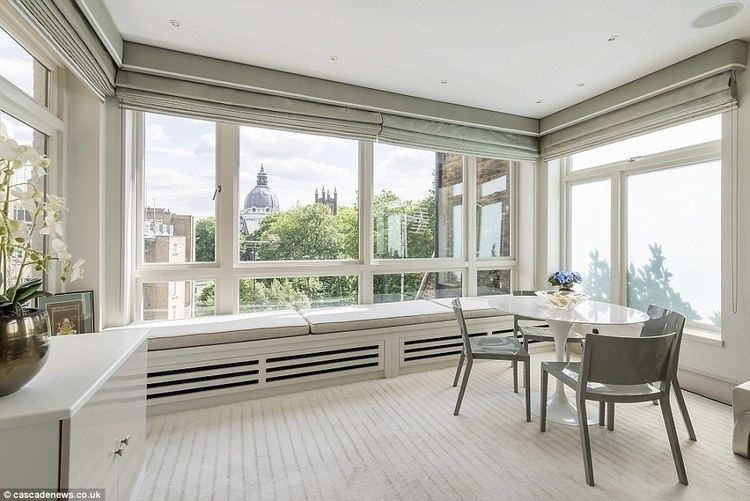 | ||
The Kingston House estate in Knightsbridge in the Royal Borough of Kensington and Chelsea, London, is situated between Prince's Gate and Ennismore Street. It includes several streets of privately owned houses including Ennismore Gardens, and the prestigious 1930s double-block of flats called Kingston House, fronting onto Knightsbridge, built on the site of the demolished townhouse of Evelyn Pierrepont, 2nd Duke of Kingston-upon-Hull (1711-1773). The estate is situated in the local government wards of Knightsbridge and Belgravia.
Contents
- Map of Ennismore Gardens Knightsbridge London SW7 UK
- Kingston House
- Development of the estate
- 20th Century developments
- Kingston House North
- Kingston House South
- Moncorvo House since demolished
- Bolney House since demolished
- Ennismore Gardens
- Ennismore Gardens Mews
- References
Map of Ennismore Gardens, Knightsbridge, London SW7, UK
Kingston House
Kingston House, originally called Chudleigh House, was a Palladian mansion, built in the mid-eighteenth century by Evelyn Pierrepont, 2nd Duke of Kingston-upon-Hull (1711-1773) for his mistress and later bigamous wife Elizabeth Chudleigh (1720-1788). On her death in 1788, the property passed to the Duke’s nephew Charles Pierrepont, 1st Earl Manvers, and had a series of tenants, including Sir George Warren, MP, and the 6th Earl of Stair and Edward Loveden of Buscot Park.
In 1813 the estate was sold to William Hare, Baron Ennismore, later 1st Earl of Listowel. He died at Kingston House in 1837 and was succeeded by his grandson William Hare, 2nd Earl of Listowel who was not regularly in residence, and sold parts of the estate for redevelopment. The house was again let out to tenants including Richard Wellesley, 1st Marquess Wellesley, who died there in 1842, and Baron Lionel de Rothschild.
Kingston House remained in the ownership of the Hare family until the death of the 4th Earl in 1931, when the estate passed to his younger son, Viscount Blakenham. In 1935 the house was sold for redevelopment and following the death of the Dowager Countess of Listowel in 1936, the house was demolished in 1937 and replaced by two large blocks of private apartments, Kingston House North and Kingston House South.
Development of the estate
In the 1840s, development began with the construction of houses on Princes Gate and the east side of Ennismore Gardens, as well as a public house, the Ennismore Arms. The pub was the first building to be constructed on the new Kingston House estate, and was built in 1845-7. It stood at the southern end of Ennismore Mews, which ran behind the houses on the eastern side of Princes Terrace. It suffered bomb damage during World War II and was rebuilt by Watney’s in the 1950s. It was closed in 2002 and subsequently demolished.
All Saints' Church in Ennismore Mews was built in 1848–9 in Italianate style: William Ralph Inge was vicar there 1904-1907. The church closed in 1955, and is now the Russian Orthodox Patriarchial Church of The Assumption of All Saints, part of the Russian Orthodox Diocese of Sourozh. The organ from All Saints was reinstalled at the Church of St John-at-Hackney.
In the 1860s the 3rd Earl released more land; the rest of Ennismore Gardens, including the private garden square at its centre, was laid out in the 1870s. The five-storey houses have porticos with Corinthian columns, and a continuous railing creating a first floor balcony.
Moncorvo House was completed in 1880 for Albert George Sandeman (future Governor of the Bank of England) and named in honour of his father-in-law, Portugal’s ambassador in London, the Visconde Da Torre de Moncorvo. In 1883, Bolney House was built for Alfred Huth, son of Henry Huth.
20th Century developments
From the 1930s onwards, many of the original buildings, including Kingston House itself, were replaced by apartment blocks and modern townhouses. The Second World War brought further changes in use of the pre-war mansions. Moncorvo House became the post-war London HQ of the Canadian Joint Staff Establishment and the Embassy of Morocco before being demolished in 1964 and replaced with Moncorvo Close. Bolney House was also demolished in the 1960s and replaced with Bolney Gate.
In World War II, the Norwegian government-in-exile was based in Kingston House North.
After World War II, the redevelopment of the original Kingston House site was completed with the building of Kingston House East and Kingston House South.
The independent Hampshire School was based at 63 Ennismore Gardens from 1933-2008, when it moved to the former Chelsea Library.
Ava Gardner lived at 34 Ennismore Gardens and is commemorated by an ornamental urn in the square. She could be spotted going for a swim in the nearby Imperial College pool with a towel rolled under her arm.
The Libyan consulate and visa office is at 61-62 Ennismore Gardens; the main embassy is at 15 Knightsbridge.
Ennismore Garden Mews is a popular filming location. Alfred Hitchcock used No 31 as the home of Barbara Leigh-Hunt's character, 'Brenda Blaney', in the 1972 film Frenzy. The 1987 VW Golf TV advert directed by David Bailey featured Paula Hamilton leaving No 23 Ennismore Garden Mews.
In 2011, the average house price in Ennismore Gardens was £3,345,000.
Kingston House North
Kingston House South
Moncorvo House (since demolished)
Bolney House (since demolished)
Ennismore Gardens
The first residents were aristocrats and statesmen; in the 20th century they were joined by artists and actors.
